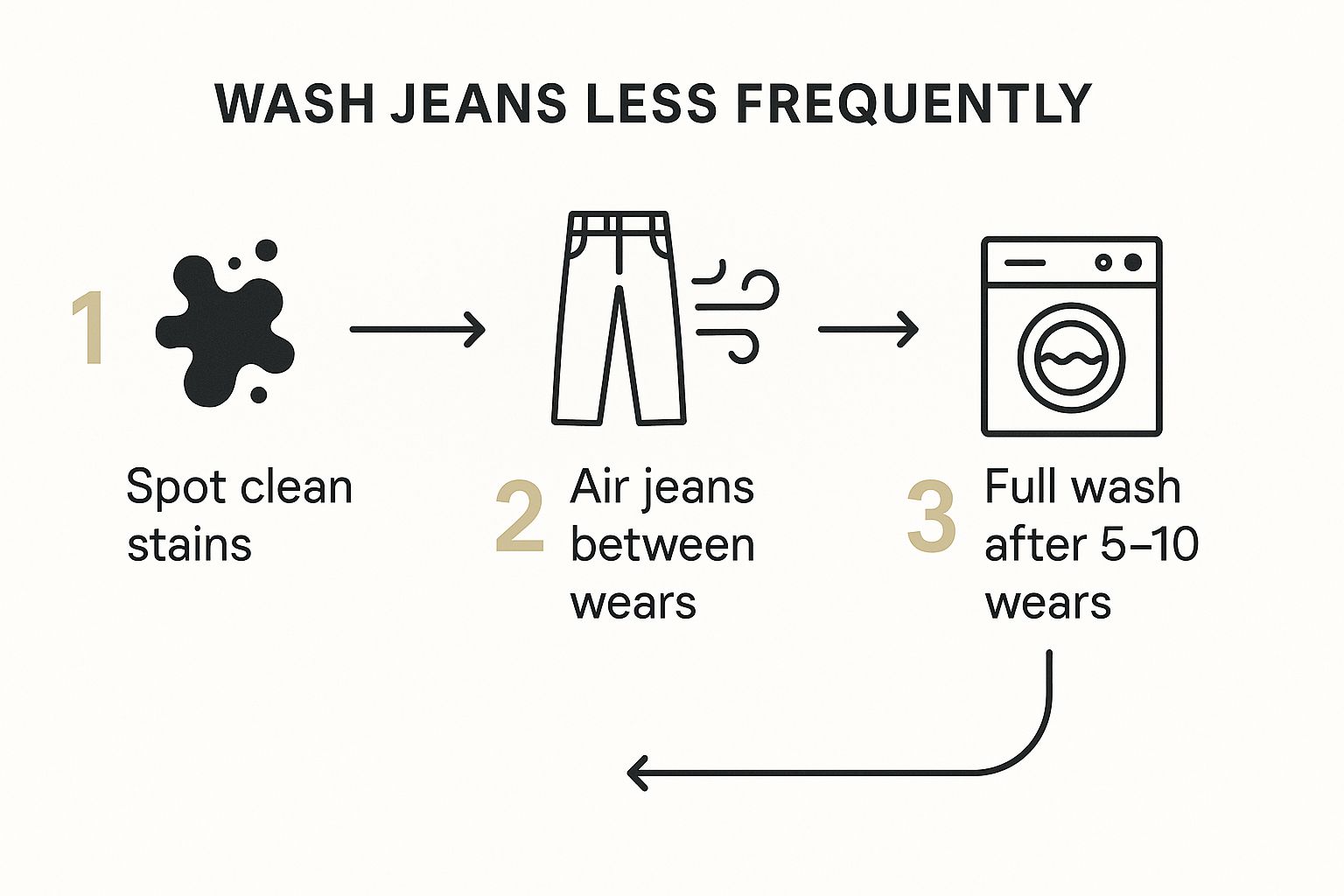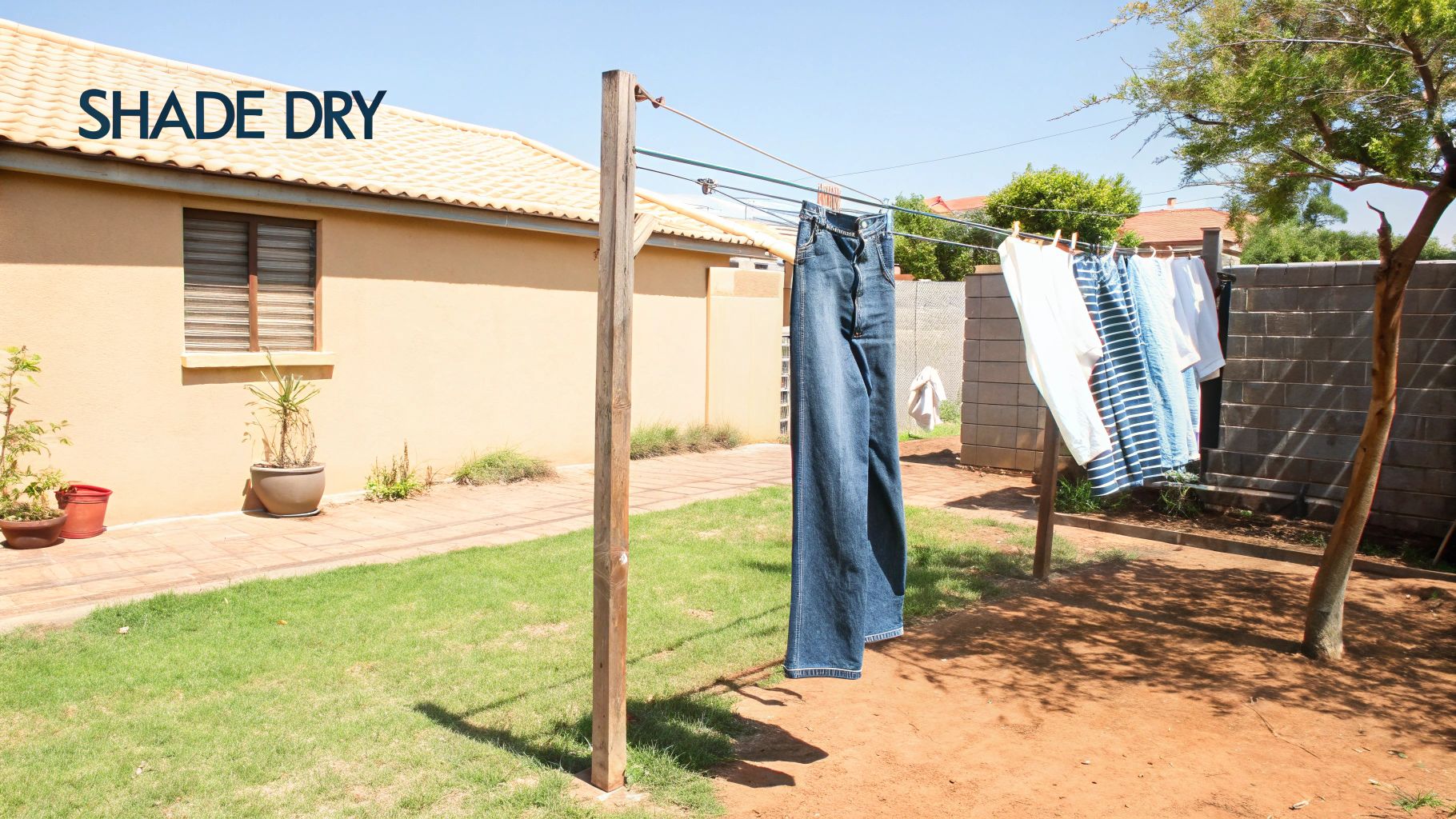How to Keep Jeans from Fading: Tips to Keep Them Looking New

It feels like a personal tragedy, watching that perfect pair of dark-wash jeans—the ones that fit just right—slowly lose their rich, deep color with every wash. But that gradual fade isn't a flaw. It’s actually part of the magic of denim, a story written into the very threads of the fabric.
To really get why this happens, we have to look at the heart of your jeans: the dye itself.

The Soul of Indigo Dye
Unlike dyes that soak deep into a fabric’s core, indigo dye mostly just clings to the surface of the cotton yarn. It’s more of a beautiful, brittle coating than a permanent stain. This is precisely what gives denim its iconic character—the ability to wear in and develop unique fade patterns that tell the story of your life.
But this surface-level relationship also makes the color incredibly delicate. Every single time your jeans go through a wash cycle, or even just rub against a chair, a microscopic amount of that indigo gets scraped away. It's why the knees, thighs, and seams—the areas that see the most action—are always the first to lighten.
The Real Story: Fading isn’t a sign that your jeans are cheap or poorly made. It’s the intended, beautiful result of indigo dye wearing away from the surface of the fibers over time.
The Everyday Habits That Steal Color
While some fading is inevitable (and even desirable), our laundry habits can turn a slow, graceful aging process into a rapid color drain. The main culprits are probably sitting in your laundry room right now.
- Hot Water: Think of hot water as an open invitation for dye to leave. It makes the cotton fibers swell up and release those loosely-bonded indigo molecules.
- Rough Wash Cycles: That aggressive tumbling and spinning in a normal wash cycle is like taking sandpaper to your jeans, physically scrubbing the color right off.
- Harsh Detergents: Many standard detergents are packed with bleaches and optical brighteners designed to make whites whiter, but on dark denim, they just strip the color away.
- The Dryer's Intense Heat: A machine dryer is denim’s worst enemy. The high heat doesn't just accelerate fading; it can fry the delicate stretch fibers (like elastane) that give modern jeans their comfortable fit.
The good news is that by simply tweaking your routine to avoid these things, you can take back control. You can keep your favorite jeans looking rich and dark for so much longer.
How To Wash Jeans Without Fading
The washing machine is often where our favorite jeans lose their rich, deep color. But it doesn't have to be a losing battle. With a few simple shifts in your laundry routine, you can keep that perfect indigo hue looking fresh and vibrant for years. It's time to forget the old habits of hot water and harsh cycles; the real secret lies in a much gentler approach.
Your first line of defense is beautifully simple. Before your jeans even touch the water, always turn them inside out. This small act is surprisingly powerful. It shields the dyed outer surface from the friction of the wash, dramatically cutting down on how much color gets rubbed away. Think of it as putting a protective layer between your denim and the machine.
Embrace Cold Water and a Gentle Touch
Heat is the enemy of indigo dye. When you wash jeans in hot water, the cotton fibers expand and release their color into the wash—the very definition of fading. That's why a cold water wash is absolutely non-negotiable. It keeps the fibers tight and the dye locked right where it belongs.
Combine this with the gentlest cycle your machine has to offer. A delicate or hand-wash setting drastically reduces the tumbling and friction that physically scrubs the color out of the fabric. It's a calmer, less stressful experience for your denim, which helps preserve not only the color but also the stretch fibers that give your JAG Jeans that perfect, body-hugging fit. You can dive deeper into the specifics in our complete guide on how to wash jeans.
The Vinegar Trick for Setting Color
One of the oldest and most effective tricks in the book involves a simple household staple: white vinegar. It works as a natural mordant, or dye fixative, helping to lock the indigo into the denim's fibers. Just add half a cup of distilled white vinegar to your washer's first cycle. It’s a brilliant, chemical-free way to reduce color bleeding over the long haul.
Of course, the best way to prevent fading from washing is to wash less often. This isn't about being unhygienic; it's about being smart.

Spot cleaning minor spills and airing out your jeans between wears is often all they need. You can easily get five or more wears out of a pair before they need a full wash.
To make things easy, here’s a quick checklist to run through every time your denim needs a deep clean.
Jean Washing Best Practices Checklist
| Action | Why It Works |
|---|---|
| Turn Jeans Inside Out | Protects the dyed surface from direct friction and abrasion. |
| Use Cold Water Only | Prevents cotton fibers from swelling and releasing dye. |
| Select a Gentle/Delicate Cycle | Minimizes harsh tumbling that physically scrubs color away. |
| Add 1/2 Cup of White Vinegar | Acts as a natural fixative to lock in the indigo dye. |
| Wash Only When Necessary | Reduces overall wear and tear and limits color loss over time. |
These simple steps will become second nature, ensuring every wash is as gentle as possible.
Key Takeaway: Washing jeans is all about a gentle touch. Always opt for cold water on a delicate cycle, turn them inside out, and think about using a vinegar rinse to set the dye. Most importantly, wash them only when you really have to.
Many of these fabric care principles are universal. In fact, if you look at a guide on caring for cotton sheets to make them last, you'll notice similar gentle methods. Applying this mindset can extend the life of all your favorite textiles, denim included.
Drying Your Denim the Right Way

Once your jeans have had their gentle wash, how you dry them is just as crucial in the mission to preserve that perfect, deep indigo. The biggest mistake you can make? Tossing them straight into a tumble dryer on high heat. Think of that intense heat as an express lane to a faded, tired-looking pair of jeans. It breaks down the dye and prematurely ages the fabric.
The best method is also the simplest and most timeless: air-drying. It’s a beautiful, zero-cost ritual that protects the color and extends the life of the fabric—especially those delicate stretch fibers that give your favorite jeans their incredible, figure-hugging fit.
The Art of Air-Drying
For the best results, turn your jeans right-side out again after the wash cycle finishes. Hang them from the waistband on a clothesline or a simple drying rack. This simple trick allows air to circulate freely and lets gravity do the work of pulling out wrinkles, helping you avoid that stiff, cardboard-like feeling. If you’re drying them inside, a small fan placed nearby will work wonders to speed things up.
Now for the most important secret: avoid direct sunlight at all costs. The sun’s UV rays are a powerful natural bleach, and they will strip the color you’ve worked so hard to protect. Always, always hang your dark denim in a shady spot, whether you’re drying them indoors or out.
Key Insight: Think of your dryer's high heat setting as a fast-forward button for fading. Air-drying in the shade is the pause button, preserving your denim’s original color and feel for much longer.
Sometimes, life gets in the way and air-drying just isn't practical. You can still use your machine, but only if you do it with care.
- No Heat or Air Fluff: Look for a cycle that tumbles your jeans gently without blasting them with heat. This will help soften the fabric without cooking the dye.
- Lowest Heat Possible: If you absolutely must use heat, choose the most delicate, low-temperature setting your machine offers.
- Pull Them Out While Still Damp: This is a game-changer. Take your jeans out before they’re bone-dry and hang them to finish. It prevents that over-dried, shrunken feeling and helps them maintain their shape and softness beautifully.
How to Shop for Fade-Resistant Denim
The smartest way to keep your jeans from fading begins long before you even think about the first wash. It starts right there in the store. Learning what to look for on the tag can make all the difference, setting you up with a pair that’s built to hold its color from day one.
Not all denim is created equal. The secret to a long-lasting, vibrant pair often lies in the fabric's composition, and that's where cotton comes in.
Jeans crafted from 100% cotton or high-cotton blends are your best defense against premature fading. These natural fibers are incredibly durable and really excel at holding onto dye when you care for them correctly. It’s no surprise, then, that over 53% of people expect their cotton-blend jeans to last at least a year without losing their color. You can explore more on why consumers put their trust in cotton denim here.
Check the Tag and Feel the Fabric
When you're shopping, get into the habit of flipping over that little care label. It’s your roadmap. While a touch of elastane (spandex) adds that comfortable stretch we all love, a higher cotton percentage is usually a good sign for better color retention down the road.
Beyond the fiber content, pay attention to the type of denim itself. You'll generally run into two main categories:
- Raw Denim: This is the pure stuff—unwashed, untreated, and stiff right off the rack. It’s a bit of a project, as it molds to your body over time, creating fade patterns that are completely unique to you. It demands some patience but rewards you with unparalleled durability.
- Pre-washed Denim: Most jeans you'll find are pre-washed (often called "sanforized") to soften them up and prevent major shrinkage. They’re comfortable from the moment you try them on, but they've already been through processing, which can sometimes affect their long-term color stability.
Pro Tip: When you’re eyeing a pair of dark-wash jeans, actually feel the fabric. A heavier, more substantial denim often points to a higher quality weave that will stand up better to fading and wear over time.
Choosing the right pair from the very beginning is a key strategy for anyone looking for reliable, long-lasting style. If you want a little more inspiration, check out our guide on finding the best jeans for women over 60. By becoming a more discerning shopper, you’re not just buying a pair of jeans—you’re investing in denim designed for a longer, more vibrant life.
Where Fade-Proof Denim Begins: The Magic of Modern Tech

The secret to keeping your jeans from fading isn't just about what you do in the laundry room. It actually starts long before they even reach your closet, right on the factory floor. The best brands are looking beyond the wash cycle and are using incredible new manufacturing methods to lock in that perfect color from day one.
These aren't your grandpa's jeans. We're moving away from old-school dyeing that guzzled water and energy. Instead, new technologies apply color with incredible precision, bonding the dye deep within the fibers. The result? Jeans that are born to resist fading from wash and wear.
Dyes That Cling and Colors That Last
So, what’s the new magic? A lot of it comes down to things like foam dyeing and laser treatments. It sounds futuristic, but these techniques create a stronger, more uniform color that holds up beautifully over time. It’s a game-changer for anyone who loves a deep, dark wash and wants it to stay that way.
This isn’t just good news for your wardrobe; it’s a massive win for the planet. These forward-thinking methods are making a real difference.
By some estimates, these new processes can slash water consumption by up to 80% and cut emissions by around 25% compared to traditional denim production. It’s a beautiful thing when looking good and doing good go hand-in-hand.
When you choose a pair of jeans made this way, you're not just getting a piece that will look better for longer. You're getting denim that was crafted with care for both longevity and the environment. It also happens to be a big reason why today's jeans can feel so good right off the rack. Speaking of which, if you're curious about what makes for that buttery feel, you'll love our article on what goes into creating truly soft denim jeans.
Got Questions? Let's Talk Denim Care
Even when you have a solid laundry plan, denim care seems to have its own set of rules and whispered secrets. When you’re trying to keep that perfect indigo shade from fading, the small details really do matter. Let's clear up some of the most common questions and myths so you can keep your favorite pair looking new.
The biggest question I always get is about washing. How often is too often? There isn't one perfect answer, but most denim lovers I know agree: wash them as little as you can get away with. For most people, that works out to about every 5 to 10 wears.
Of course, it all depends on your life. If you’ve been out in the garden or they’re starting to smell, it’s definitely time for a wash. Otherwise, a little spot cleaning and letting them air out between wears is your best friend.
Another rumor that just won't quit is freezing your jeans. The idea is that it kills bacteria and odors, making it a substitute for washing. While the cold might quiet down some of the odor-causing bacteria for a bit, they'll wake right back up once your jeans are at room temperature.
The real story: Freezing isn't a replacement for cleaning. For jeans that are actually fresh and hygienic, nothing beats a proper cold-water wash.
How Fit Affects Fading
Believe it or not, how your jeans fit plays a quiet but important role in how they wear and fade. A pair that’s too tight gets a lot more friction and stress, especially at the seams and across the thighs. This constant rubbing can cause the color to wear away much faster in those spots.
Taking a moment to understand how different cuts are meant to fit can make a world of difference for both comfort and how long your jeans last. If you're curious about different styles, our comprehensive jeans fit guide is a great place to start. It can help you find a silhouette that feels like it was made for you, which helps them wear more evenly over time.
Finally, what's the deal with setting the dye? You've probably heard a few tricks involving salt or vinegar for that very first wash.
- White Vinegar: This one actually works. Add about half a cup to the first wash cycle. The mild acid helps lock the indigo dye into the cotton fibers.
- Salt: Some people swear by adding a teaspoon of salt to the first wash, thinking it helps stop the dye from bleeding. It's an old trick, but vinegar is generally the more effective option.
With these little tips in your back pocket, you can handle the nuances of denim care like a pro.
At JAG Jeans, we design denim that blends timeless style with the kind of comfort you can live in, so you can enjoy your favorite pair for years. Find your own perfect fit and see our collection at https://www.jagjeans.com.
Recent Blogs
How to Keep Jeans from Fading: Tips to Keep Them Looking New
Learn how to keep jeans from fading with simple tips....
How to Keep Jeans from Fading: Tips to Keep Them Looking New
Learn how to keep jeans from fading with simple tips....
How to Keep Jeans from Fading: Tips to Keep Them Looking New
Learn how to keep jeans from fading with simple tips....